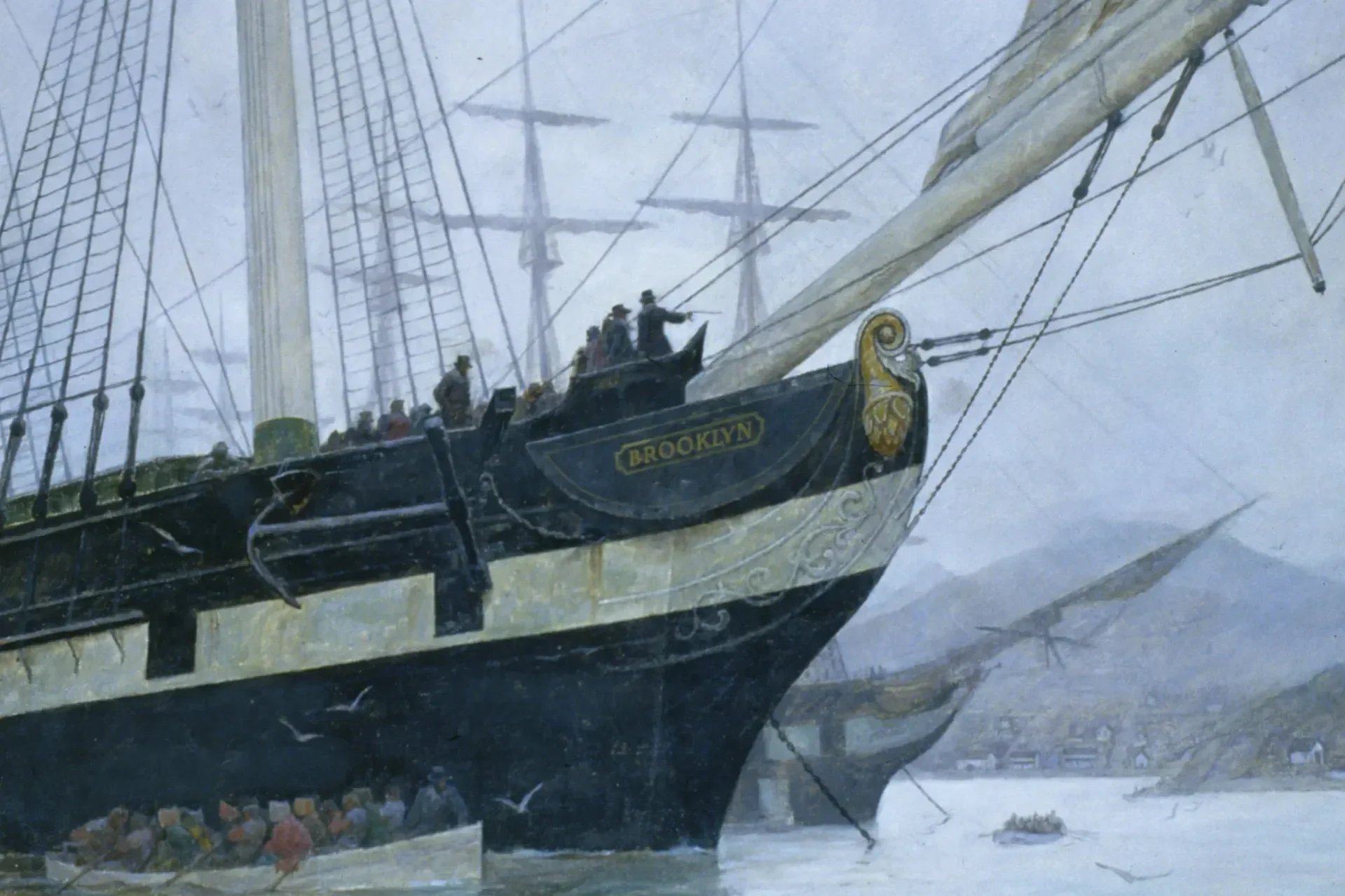Dissertation Preview - The Forgotten Pioneers: Latter-day Saints from the Ship ‘Brooklyn’
Pioneers Arrive by Ship in San Francisco Bay (Ship Brooklyn) by Arnold Friberg.
In 1846, seeking refuge from intense persecution in the United States, a small group of Latter-day Saints boarded the ship Brooklyn in pursuit of a new California-based Zion. While they could not have foreseen the formative impact their pioneering journey would have on California—nor how quickly it would be forgotten—this research seeks to recover their story and situate it in the broader context of Latter-day Saint and regional history.
The thesis is that the 1846 arrival of Latter-day Saint pioneers from the ship Brooklyn to California had a significant impact on the early development and colonization of the San Francisco Bay Area during the mid-1800s. Thesis-driven research questions center around the Saints’ impact on prioritizing public education, contributing to the development of several settlements, enabling rapid advancements in inter- and intra-area connections and communication, making mixed contributions to the reputation of their Church in California, and helping to redefine what it meant to be Californian in the mid-1800s. The research seeks to identify how they were able to make such an impact and the lasting effects of their time in California. To narrow the project’s scope and allow for a more comprehensive analysis of the principal causative forces and their consequences, the research highlights the influence of specific individuals and families, including Samuel Brannan, William Glover, John Horner, and Augusta Crocheron.
Mr. Horner, The Greatest Farmer in California, drawing, in Gleason’s Pictorial Drawing-Room Companion, Sept. 16, 1854, 164.
This research is historically significant because it reveals a largely forgotten aspect of Latter-day Saint pioneer history as it intersects with western migration and early California history. It helps to overcome the historiographical problem that most people do not know that any Saints traveled west by sea, that their arrival in California predated the main body of church members reaching Utah territory, or the role that they played in the pioneering work of the mid-nineteenth century. Additionally, their story is difficult to find in church-sponsored collections of pioneer stories, further limiting widespread familiarity with their story. The California Gold Rush—which occurred shortly after the Brooklyn’s arrival—often overshadows the Saints’ early efforts to develop the San Francisco Bay Area. By analyzing examples of lived religion, entrepreneurship, innovation, cultural integration, contested governance, violence, and economic instability, this research demonstrates the Brooklyn Saints’ impact on the early development of the Bay Area.
The research’s main historiographical fault lines center on changing attitudes—both within and outside the Church—toward the Brooklyn Saints’ role in the development of the San Francisco Bay Area in the mid-nineteenth century. Early non-Latter-day Saint writers praised their contributions without overemphasizing their leader, Sam Brannan. By the early twentieth century, revisionists painted Brannan as the principal pioneer and downplayed the other Saints’ contributions. Latter-day Saint interpretations, on the other hand, change from seeing the Brooklyn Saints as pioneers, to faithless non-pioneers, to something in between. Despite oscillating historical opinions both within and outside the Church, acknowledgment of the Brooklyn Saints’ contributions is largely absent from both contemporary scholarly discussion and public memory.
To that end, this study employs multiple methodologies including traditional documentary analysis, the microhistory of specific Saints, quantitative analysis of the Saints’ resources, comparative economic history of San Francisco over time, migration history relative to borderland theory and the changing identity of Californians, and religious history—especially as it relates to the Saints’ religious impact in California. To ensure that the findings are grounded in extant firsthand documentation, the principal evidence for this research is a wide array of primary source documents including memoirs, exploration reports of California, shipping manifests, newspaper articles, personal correspondence, speeches, and meeting notes. To support the thesis, provide substantive analysis, and situate arguments in their broader scholarly context, secondary sources include regional histories, official histories of the Church, and scholarly analyses of the period.
Horner School House, photograph, approximately 1850, Alameda County, California, in Our Pioneer Heritage, by Kate B. Carter, 3:511.
This research builds on the author’s previous graduate-level work examining the intersection of migration and Latter-day Saint history in the mid-nineteenth-century American West. The author has a master’s degree in history and is currently completing his doctoral degree in history, both of which sharpen his skills in historical research, source criticism, objective analysis, and historiographical assessment. Moreover, the author has extensive experience researching and teaching Latter-day Saint history.
While the Bay Area was not the final destination for many of the Brooklyn Saints, their impact on its founding paved the way for dramatic growth over the coming decades, both within their church and among the general population. This research is relevant not only to current members of the Church of Jesus Christ of Latter-day Saints, but also to anyone interested in the history and early development of California. While the historiography of the Brooklyn Saints has changed dramatically over time, even the most recent scholarly publications on the group do not give them much attention in the context of pioneers. Consequently, this targeted research about the Brooklyn Saints’ impact on the development of the San Francisco Bay Area in the mid-nineteenth century is both warranted and necessary.


